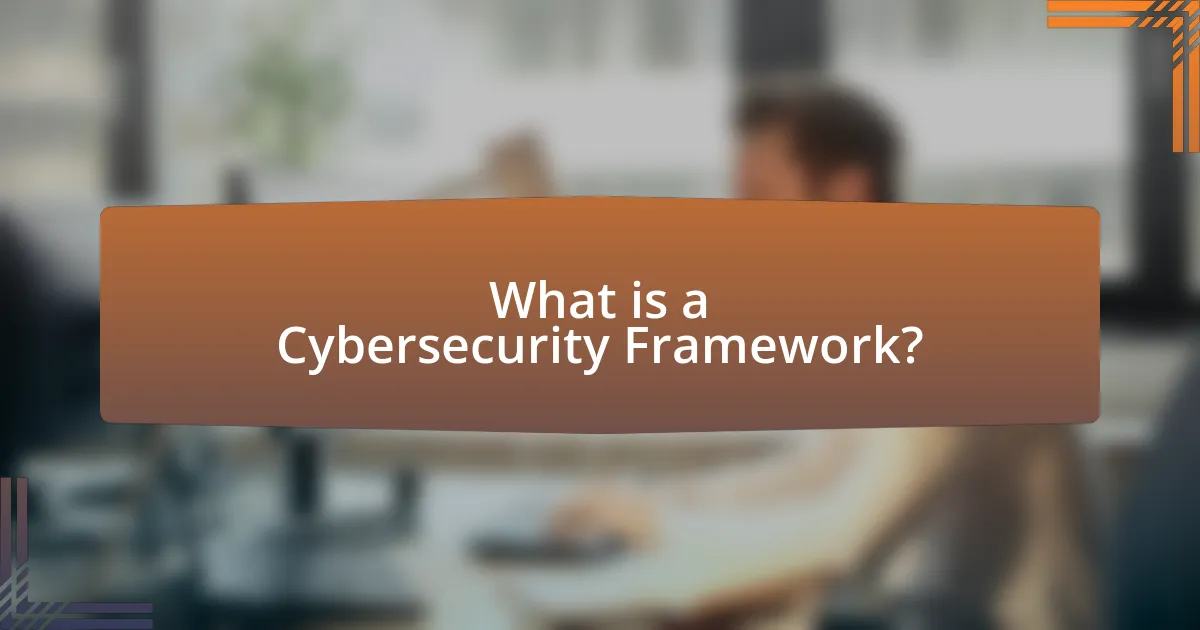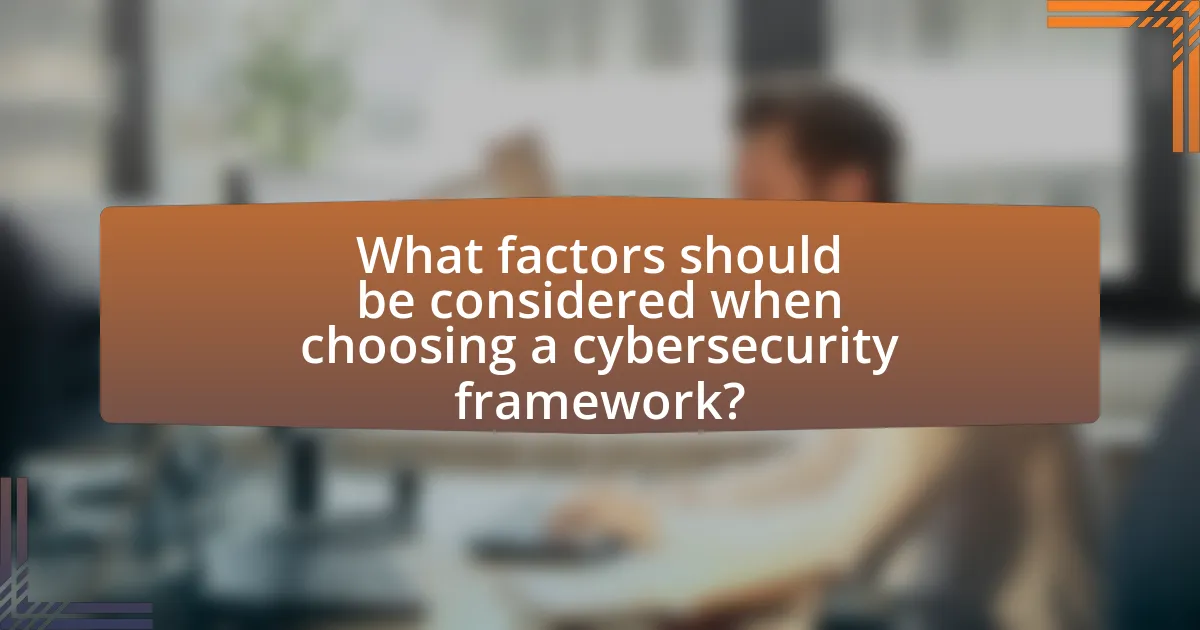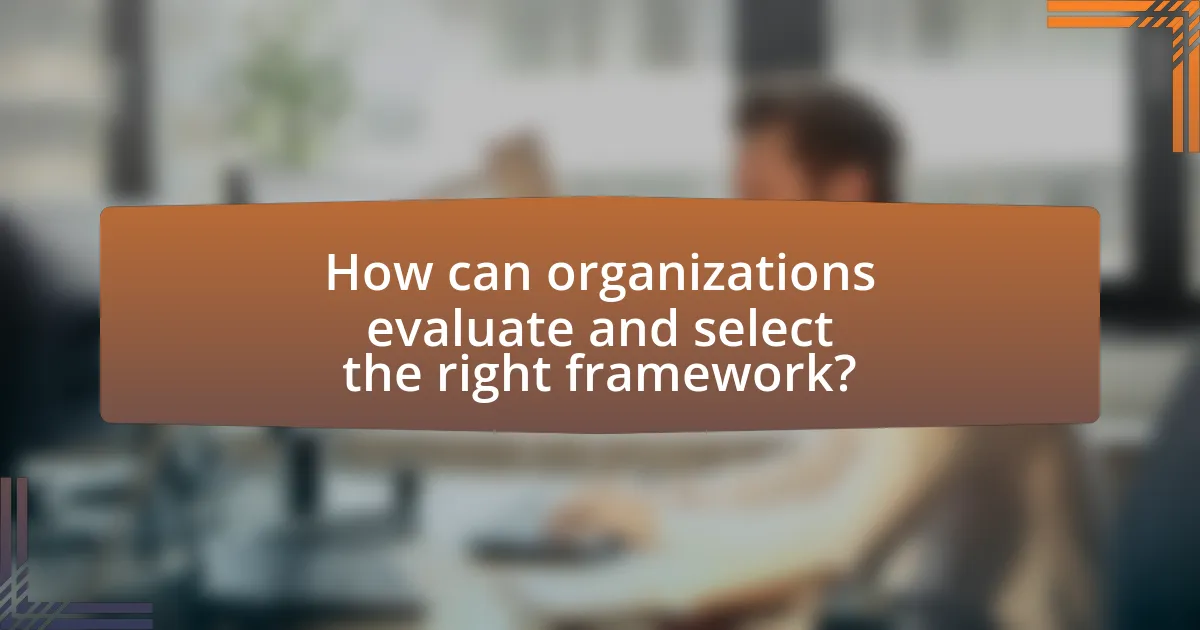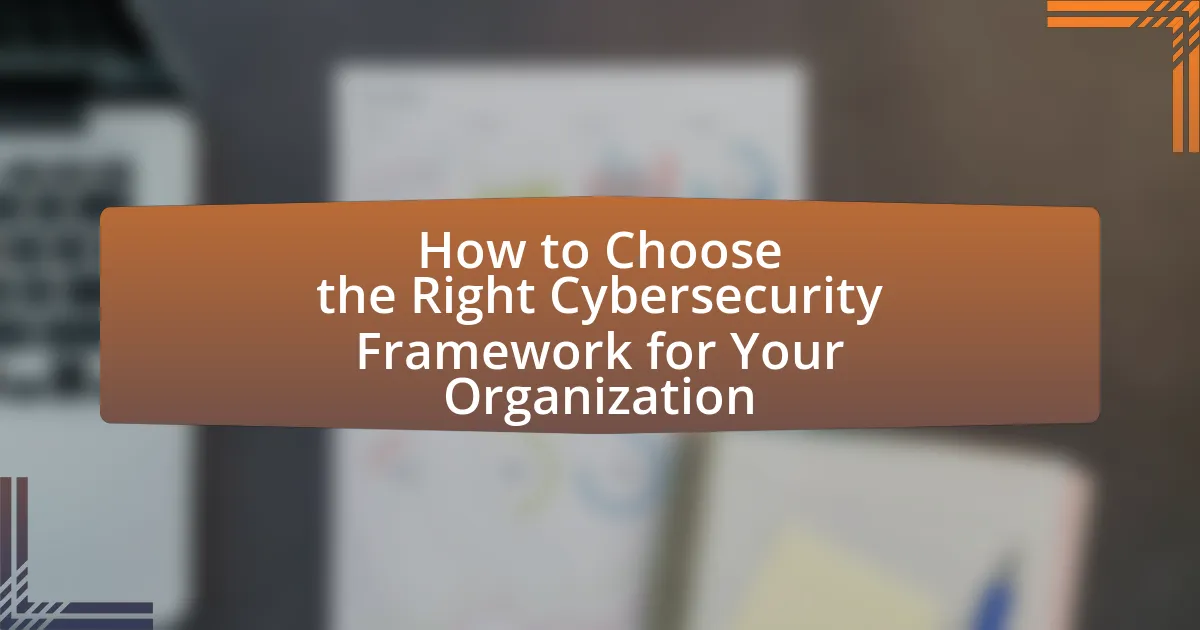The article focuses on selecting the appropriate cybersecurity framework for organizations, emphasizing the importance of structured guidelines to manage and mitigate cybersecurity risks. It outlines key components of cybersecurity frameworks, such as risk assessment, security controls, incident response, and continuous monitoring, and discusses how these elements interact to enhance security. The article also highlights the significance of aligning the chosen framework with regulatory compliance, organizational size, and industry-specific requirements, while detailing popular frameworks like the NIST Cybersecurity Framework, ISO/IEC 27001, and CIS Controls. Additionally, it addresses best practices for implementation and ongoing evaluation to ensure effective cybersecurity management.

What is a Cybersecurity Framework?
A cybersecurity framework is a structured set of guidelines and best practices designed to manage and reduce cybersecurity risks. These frameworks provide organizations with a systematic approach to identifying, assessing, and mitigating security threats, ensuring compliance with regulations and enhancing overall security posture. For example, the NIST Cybersecurity Framework, developed by the National Institute of Standards and Technology, outlines core functions such as Identify, Protect, Detect, Respond, and Recover, which help organizations establish a comprehensive cybersecurity strategy.
How do cybersecurity frameworks function?
Cybersecurity frameworks function as structured guidelines that organizations use to manage and reduce cybersecurity risks. These frameworks provide a set of best practices, standards, and controls that help organizations identify, assess, and mitigate security threats. For example, the NIST Cybersecurity Framework outlines five core functions: Identify, Protect, Detect, Respond, and Recover, which guide organizations in establishing a comprehensive cybersecurity strategy. By implementing these frameworks, organizations can enhance their security posture, ensure compliance with regulations, and improve their ability to respond to incidents effectively.
What are the key components of a cybersecurity framework?
The key components of a cybersecurity framework include risk assessment, security controls, incident response, and continuous monitoring. Risk assessment identifies potential threats and vulnerabilities, allowing organizations to prioritize their security measures. Security controls are the safeguards implemented to protect information systems, which can include technical, administrative, and physical measures. Incident response outlines the procedures for detecting, responding to, and recovering from security incidents, ensuring that organizations can effectively manage breaches. Continuous monitoring involves regularly reviewing and updating security practices to adapt to evolving threats and maintain compliance with regulations. These components collectively enhance an organization’s ability to manage cybersecurity risks effectively.
How do these components interact to enhance security?
The components of a cybersecurity framework interact to enhance security by creating a layered defense strategy that addresses various vulnerabilities. Each component, such as risk assessment, incident response, and continuous monitoring, works in tandem to identify threats, mitigate risks, and respond effectively to incidents. For instance, risk assessment identifies potential vulnerabilities, which informs the incident response plan, ensuring that organizations are prepared to act swiftly when a threat is detected. Continuous monitoring provides real-time data that feeds back into the risk assessment process, allowing for ongoing adjustments to security measures. This interconnectedness ensures a comprehensive approach to cybersecurity, reducing the likelihood of breaches and enhancing overall organizational resilience.
Why is it important to choose the right cybersecurity framework?
Choosing the right cybersecurity framework is crucial because it directly impacts an organization’s ability to effectively manage risks and protect sensitive information. A well-suited framework aligns with the specific regulatory requirements and operational needs of the organization, ensuring comprehensive coverage against potential threats. For instance, the NIST Cybersecurity Framework has been adopted by numerous organizations due to its flexibility and focus on risk management, which enhances their security posture. Additionally, selecting an appropriate framework can lead to improved incident response times and reduced costs associated with data breaches, as evidenced by a study from IBM that found organizations with a formal cybersecurity framework experienced 50% lower costs related to breaches.
What risks are associated with not having a proper framework?
Not having a proper cybersecurity framework exposes organizations to significant risks, including increased vulnerability to cyberattacks, regulatory non-compliance, and inefficient resource allocation. Without a structured approach, organizations may lack the necessary protocols to identify, assess, and mitigate threats effectively, leading to potential data breaches. For instance, a report by IBM found that organizations with a formal cybersecurity framework experienced 50% lower data breach costs compared to those without one. Additionally, regulatory bodies often require adherence to specific frameworks; failure to comply can result in hefty fines and legal repercussions. Thus, the absence of a proper framework not only jeopardizes security but also impacts financial stability and legal standing.
How can the right framework improve organizational security posture?
The right cybersecurity framework can significantly enhance an organization’s security posture by providing structured guidelines and best practices for identifying, managing, and mitigating risks. By implementing a recognized framework, such as the NIST Cybersecurity Framework, organizations can establish a comprehensive approach to security that aligns with their specific needs and regulatory requirements. This structured approach enables organizations to systematically assess vulnerabilities, prioritize security measures, and allocate resources effectively, leading to improved resilience against cyber threats. Studies show that organizations adopting such frameworks experience a reduction in security incidents and enhanced compliance with industry standards, thereby validating the effectiveness of using a structured framework to bolster security posture.

What factors should be considered when choosing a cybersecurity framework?
When choosing a cybersecurity framework, organizations should consider factors such as regulatory compliance, organizational size, industry-specific requirements, risk management needs, and existing security posture. Regulatory compliance ensures that the framework aligns with laws and standards relevant to the organization, such as GDPR or HIPAA. The size of the organization influences the complexity and scalability of the framework, as larger organizations may require more robust solutions. Industry-specific requirements dictate the need for frameworks that address unique threats and vulnerabilities pertinent to that sector, such as finance or healthcare. Risk management needs focus on the organization’s specific risk tolerance and threat landscape, guiding the selection of a framework that effectively mitigates identified risks. Lastly, the existing security posture helps determine how well the framework integrates with current security measures and technologies, ensuring a cohesive approach to cybersecurity.
How does the size of an organization influence framework selection?
The size of an organization significantly influences framework selection by determining the complexity, resources, and specific needs that the framework must address. Larger organizations typically require more comprehensive frameworks that can handle diverse operations, regulatory compliance, and extensive risk management, such as the NIST Cybersecurity Framework or ISO 27001. In contrast, smaller organizations may opt for simpler, more cost-effective frameworks like the CIS Controls, which provide essential security measures without overwhelming resource demands. This distinction is supported by a 2021 study from the Ponemon Institute, which found that 70% of large organizations reported needing a tailored approach to cybersecurity frameworks due to their complex environments, while 60% of small businesses preferred straightforward frameworks that are easier to implement and maintain.
What specific needs do small, medium, and large organizations have?
Small organizations need cost-effective cybersecurity solutions that are easy to implement and manage due to limited resources. Medium organizations require scalable cybersecurity frameworks that can adapt to their growing needs while ensuring compliance with regulations. Large organizations demand comprehensive and robust cybersecurity measures that can protect vast amounts of data across multiple locations, often necessitating advanced threat detection and incident response capabilities. These needs are validated by the fact that according to a 2021 report by Cybersecurity Ventures, 60% of small businesses close within six months of a cyber attack, highlighting the critical need for effective cybersecurity measures tailored to their size and complexity.
How does organizational culture impact framework choice?
Organizational culture significantly impacts framework choice by influencing the values, behaviors, and priorities that guide decision-making processes. For instance, a culture that prioritizes innovation may favor agile frameworks that allow for rapid adaptation, while a risk-averse culture might lean towards more traditional, compliance-focused frameworks. Research by the National Institute of Standards and Technology (NIST) indicates that aligning a cybersecurity framework with organizational culture enhances its effectiveness and acceptance among employees, leading to better implementation and adherence. Thus, understanding and integrating organizational culture into the framework selection process is crucial for achieving desired cybersecurity outcomes.
What industry-specific regulations should be taken into account?
Organizations must consider regulations such as the Health Insurance Portability and Accountability Act (HIPAA) for healthcare, the Payment Card Industry Data Security Standard (PCI DSS) for payment processing, and the General Data Protection Regulation (GDPR) for data protection in the European Union. These regulations dictate specific security measures and compliance requirements that organizations must implement to protect sensitive information. For instance, HIPAA mandates that healthcare organizations secure patient data through administrative, physical, and technical safeguards, while PCI DSS requires businesses that handle credit card information to adhere to strict security protocols to prevent data breaches. Compliance with these regulations not only helps organizations avoid legal penalties but also enhances their overall cybersecurity posture.
Which frameworks are tailored for specific industries?
Frameworks tailored for specific industries include the Health Insurance Portability and Accountability Act (HIPAA) for healthcare, the Payment Card Industry Data Security Standard (PCI DSS) for payment processing, and the Federal Risk and Authorization Management Program (FedRAMP) for cloud services in government. These frameworks provide industry-specific guidelines and requirements to ensure compliance and enhance security measures. For example, HIPAA mandates the protection of patient health information, while PCI DSS outlines security measures for handling credit card transactions, demonstrating their targeted approach to addressing unique industry challenges.
How do compliance requirements shape framework selection?
Compliance requirements significantly influence framework selection by dictating the necessary standards and practices that organizations must adhere to. Organizations often choose frameworks that align with specific regulations, such as GDPR or HIPAA, to ensure legal compliance and mitigate risks associated with non-compliance. For instance, a healthcare organization would select a framework that incorporates HIPAA guidelines to protect patient data, while a financial institution might opt for a framework that meets PCI DSS standards for payment security. This alignment not only helps in avoiding legal penalties but also enhances the organization’s credibility and trustworthiness in the eyes of stakeholders.

What are the most popular cybersecurity frameworks available?
The most popular cybersecurity frameworks available include the NIST Cybersecurity Framework, ISO/IEC 27001, and the CIS Controls. The NIST Cybersecurity Framework, developed by the National Institute of Standards and Technology, provides a policy framework of computer security guidance for how private sector organizations can assess and improve their ability to prevent, detect, and respond to cyber attacks. ISO/IEC 27001 is an international standard for information security management systems (ISMS), outlining a systematic approach to managing sensitive company information. The CIS Controls, developed by the Center for Internet Security, consist of a set of best practices designed to help organizations improve their cybersecurity posture. These frameworks are widely adopted due to their structured approach and proven effectiveness in enhancing organizational security.
What is the NIST Cybersecurity Framework?
The NIST Cybersecurity Framework is a policy framework of computer security guidance for how private sector organizations can assess and improve their ability to prevent, detect, and respond to cyber attacks. Developed by the National Institute of Standards and Technology, it consists of standards, guidelines, and practices to promote the protection of critical infrastructure. The framework is built around five core functions: Identify, Protect, Detect, Respond, and Recover, which provide a high-level strategic view of the lifecycle of managing cybersecurity risk. The framework is widely recognized and adopted across various industries, demonstrating its effectiveness in enhancing organizational cybersecurity posture.
What are the core functions of the NIST framework?
The core functions of the NIST framework are Identify, Protect, Detect, Respond, and Recover. These functions provide a comprehensive approach to managing cybersecurity risks. The Identify function helps organizations understand their environment and manage cybersecurity risk to systems, people, assets, data, and capabilities. The Protect function outlines safeguards to ensure critical infrastructure services are delivered. The Detect function defines the appropriate activities to identify the occurrence of a cybersecurity event. The Respond function includes appropriate activities to take action regarding a detected cybersecurity incident. Finally, the Recover function identifies activities to maintain plans for resilience and restore any capabilities or services that were impaired due to a cybersecurity incident. This structured approach is essential for organizations to effectively manage and mitigate cybersecurity risks.
How can organizations implement the NIST framework effectively?
Organizations can implement the NIST framework effectively by following a structured approach that includes assessing their current cybersecurity posture, aligning their practices with the framework’s core functions—Identify, Protect, Detect, Respond, and Recover—and continuously monitoring and improving their cybersecurity measures. This structured approach ensures that organizations not only adopt the framework but also integrate it into their overall risk management strategy. For instance, a 2020 survey by the Ponemon Institute found that organizations using the NIST Cybersecurity Framework reported a 30% reduction in security incidents, demonstrating the framework’s effectiveness when properly implemented.
What is the ISO/IEC 27001 standard?
The ISO/IEC 27001 standard is an international framework for establishing, implementing, maintaining, and continually improving an information security management system (ISMS). This standard provides a systematic approach to managing sensitive company information, ensuring its confidentiality, integrity, and availability. ISO/IEC 27001 is recognized globally and is essential for organizations seeking to protect their information assets and comply with legal and regulatory requirements.
What are the key principles of ISO/IEC 27001?
The key principles of ISO/IEC 27001 include the establishment of an Information Security Management System (ISMS), risk assessment and treatment, continuous improvement, and compliance with legal and regulatory requirements. The ISMS framework ensures a systematic approach to managing sensitive company information, protecting it from threats, and ensuring its confidentiality, integrity, and availability. Risk assessment and treatment involve identifying potential risks to information security and implementing appropriate controls to mitigate those risks. Continuous improvement emphasizes the need for ongoing evaluation and enhancement of the ISMS to adapt to changing threats and vulnerabilities. Compliance with legal and regulatory requirements ensures that organizations meet necessary obligations, thereby reducing the risk of legal penalties and enhancing trust with stakeholders.
How does ISO/IEC 27001 certification benefit organizations?
ISO/IEC 27001 certification benefits organizations by establishing a systematic approach to managing sensitive information, which enhances data security and builds stakeholder trust. This certification helps organizations identify and mitigate risks related to information security, ensuring compliance with legal and regulatory requirements. Furthermore, organizations with ISO/IEC 27001 certification often experience improved operational efficiency and reduced costs associated with data breaches, as they implement best practices for information security management. According to a study by the International Organization for Standardization, organizations that adopt ISO/IEC 27001 can reduce the likelihood of security incidents by up to 50%, demonstrating the tangible benefits of this certification in safeguarding information assets.
What is the CIS Controls framework?
The CIS Controls framework is a set of best practices designed to help organizations improve their cybersecurity posture. Developed by the Center for Internet Security, it consists of a prioritized list of actions that organizations can take to mitigate the most common cyber threats. The framework is based on real-world attacks and provides a clear roadmap for implementing effective security measures, making it a valuable resource for organizations seeking to enhance their defenses against cyber risks.
What are the main controls outlined in the CIS framework?
The main controls outlined in the CIS framework are categorized into 18 critical security controls designed to enhance cybersecurity posture. These controls include inventory and control of hardware assets, inventory and control of software assets, continuous vulnerability management, controlled use of administrative privileges, and secure configuration for hardware and software. Each control is aimed at addressing specific security challenges and is supported by best practices and guidelines to help organizations implement effective security measures. The CIS framework is widely recognized for its practical approach and is based on real-world experiences and expert consensus, making it a reliable resource for organizations seeking to improve their cybersecurity defenses.
How can organizations prioritize implementation of CIS Controls?
Organizations can prioritize the implementation of CIS Controls by conducting a risk assessment to identify their most critical assets and vulnerabilities. This assessment allows organizations to focus on the controls that will mitigate the highest risks first, ensuring that resources are allocated effectively. According to the Center for Internet Security, the CIS Controls are designed to provide a prioritized and actionable framework, with the first few controls addressing the most common attack vectors. By implementing these foundational controls, organizations can significantly reduce their risk exposure and enhance their overall security posture.

How can organizations evaluate and select the right framework?
Organizations can evaluate and select the right cybersecurity framework by assessing their specific security needs, regulatory requirements, and existing security posture. This process involves identifying the organization’s goals, understanding the risks it faces, and determining the compliance obligations it must meet. For instance, frameworks like NIST Cybersecurity Framework or ISO/IEC 27001 provide structured approaches that can be tailored to various organizational contexts. A study by the Ponemon Institute found that organizations using a formal framework experience 50% fewer security incidents, highlighting the effectiveness of structured approaches in enhancing security.
What criteria should be used for framework evaluation?
The criteria for framework evaluation in cybersecurity include alignment with organizational goals, compliance with regulatory requirements, adaptability to changing threats, and effectiveness in risk management. Alignment ensures that the framework supports the organization’s mission and objectives, while compliance guarantees adherence to laws and standards such as GDPR or HIPAA. Adaptability is crucial as cybersecurity threats evolve rapidly, necessitating frameworks that can adjust accordingly. Effectiveness in risk management is assessed through metrics that demonstrate the framework’s ability to identify, assess, and mitigate risks effectively. These criteria are essential for selecting a framework that not only meets current needs but also prepares the organization for future challenges.
How can organizations assess their current security posture?
Organizations can assess their current security posture by conducting comprehensive security assessments, including vulnerability assessments, penetration testing, and security audits. These assessments help identify weaknesses in the organization’s security controls and overall risk exposure. For instance, a 2021 report by the Ponemon Institute found that organizations that regularly conduct security assessments can reduce the average cost of a data breach by approximately $1.2 million. By utilizing frameworks such as NIST Cybersecurity Framework or ISO 27001, organizations can systematically evaluate their security measures against established best practices, ensuring a thorough understanding of their security strengths and vulnerabilities.
What tools can assist in the evaluation process?
Tools that can assist in the evaluation process of cybersecurity frameworks include risk assessment tools, compliance management software, and security assessment platforms. Risk assessment tools, such as FAIR (Factor Analysis of Information Risk), help organizations quantify risks and prioritize them effectively. Compliance management software, like RSA Archer, streamlines the process of ensuring adherence to various regulations and standards. Security assessment platforms, such as Nessus or Qualys, provide vulnerability scanning and assessment capabilities, enabling organizations to identify weaknesses in their systems. These tools collectively enhance the evaluation process by providing structured methodologies and actionable insights, ensuring that organizations can make informed decisions regarding their cybersecurity frameworks.
How can organizations ensure successful implementation of the chosen framework?
Organizations can ensure successful implementation of the chosen cybersecurity framework by establishing clear objectives and aligning them with the framework’s requirements. This alignment facilitates a focused approach, enabling organizations to identify specific security controls and practices that need to be adopted. Additionally, engaging stakeholders across various departments fosters collaboration and ensures that the framework is integrated into the organization’s culture. Training employees on the framework’s principles and practices enhances understanding and compliance, which is critical for effective implementation. Regular assessments and updates to the framework based on evolving threats and organizational changes further solidify its effectiveness. Research indicates that organizations that actively involve their teams and continuously adapt their strategies experience a 30% increase in successful framework adoption rates, as highlighted in the 2021 Cybersecurity Framework Adoption Report by the National Institute of Standards and Technology.
What role does training play in framework implementation?
Training is essential in framework implementation as it equips personnel with the necessary skills and knowledge to effectively apply the framework’s principles. Proper training ensures that employees understand the framework’s requirements, which enhances compliance and reduces the risk of security breaches. For instance, organizations that invest in training programs report a 45% increase in adherence to cybersecurity protocols, according to a study by the Ponemon Institute. This demonstrates that training not only facilitates the successful adoption of the framework but also strengthens the overall security posture of the organization.
How can organizations measure the effectiveness of the framework post-implementation?
Organizations can measure the effectiveness of the cybersecurity framework post-implementation by evaluating key performance indicators (KPIs) such as incident response times, the number of security breaches, and compliance with regulatory requirements. These metrics provide quantifiable data that reflects the framework’s impact on the organization’s security posture. For instance, a reduction in incident response times by 30% after implementing a framework indicates improved efficiency and effectiveness in handling security threats. Additionally, conducting regular audits and assessments can help identify gaps in security measures and ensure continuous improvement, thereby validating the framework’s effectiveness over time.
What are some best practices for choosing a cybersecurity framework?
To choose a cybersecurity framework effectively, organizations should assess their specific security needs, regulatory requirements, and existing security posture. Conducting a thorough risk assessment helps identify vulnerabilities and threats, guiding the selection of a framework that aligns with the organization’s risk tolerance and business objectives. Additionally, organizations should consider frameworks that are widely recognized and adaptable, such as NIST Cybersecurity Framework or ISO/IEC 27001, as these provide comprehensive guidelines and best practices. Engaging stakeholders across the organization ensures that the chosen framework meets diverse needs and promotes a culture of security. Finally, continuous evaluation and updates to the framework are essential to address evolving threats and compliance requirements, ensuring long-term effectiveness.
How can organizations stay updated on evolving cybersecurity threats?
Organizations can stay updated on evolving cybersecurity threats by implementing continuous monitoring and threat intelligence services. These services provide real-time data on emerging threats, vulnerabilities, and attack vectors, enabling organizations to adapt their security measures accordingly. For instance, subscribing to threat intelligence feeds from reputable sources like the Cybersecurity and Infrastructure Security Agency (CISA) or utilizing platforms such as Recorded Future can enhance an organization’s awareness of the latest threats. Additionally, participating in industry-specific information sharing and analysis centers (ISACs) allows organizations to exchange insights and experiences regarding cybersecurity incidents, further strengthening their defenses.
What resources are available for ongoing support and guidance?
Ongoing support and guidance for choosing the right cybersecurity framework can be found through various resources, including industry organizations, online communities, and professional consulting services. Organizations such as the National Institute of Standards and Technology (NIST) provide comprehensive guidelines and frameworks, such as the NIST Cybersecurity Framework, which offers a structured approach to managing cybersecurity risks. Additionally, online platforms like ISACA and (ISC)² offer forums and resources for professionals to share insights and best practices. Consulting firms specializing in cybersecurity can also provide tailored advice and support based on an organization’s specific needs and challenges.
